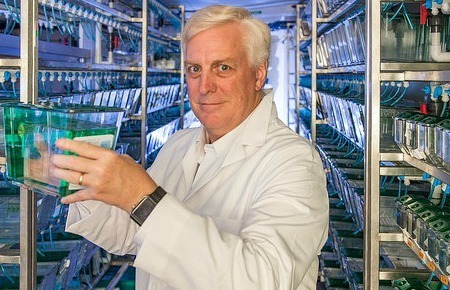
Dr. David Hyde and his team have been awarded over $1.9 million from the National Institutes of Health (NIH) to lead one of six projects planned to identify biological factors that influence neural regeneration in the retina.
The projects are part of the National Eye Institute (NEI) Audacious Goals Initiative (AGI), a targeted effort to restore vision by regenerating neurons and their connections in the eye and visual system. These six projects will receive a total of $12.4 million over three years, pending availability of funds.
“Understanding factors that mediate the regeneration of neurons and the growth of axons is crucial for the development of breakthrough therapies for blinding diseases. What we learn through these projects will have a health impact beyond vision,” said Paul A. Sieving, M.D., Ph.D., Director of the NEI, part of NIH.
“The National Eye Institute’s Audacious Goals Initiative is to regenerate neurons and neural connections in the eye and visual system to restore sight to individuals who are blind. This Audacious Goals grant award is very important for two reasons,” said Dr. Hyde. “First, it is based on regenerating the neurons from adult stem cells that are already present in the eye. This approach will reveal that in many ways, adult stem cells are potentially more powerful to regenerate neurons in an organism than embryonic stem cells. Second, by Notre Dame being the lead institution on this grant, it demonstrates that our scientific expertise, in certain research areas, rivals the top medical schools in the country. This award will bring increased visibility to Notre Dame, the Center for Stem Cells and Regenerative Medicine, and our commitment, for scientific and ethical reasons, to pursue the research and application of adult stem cells over embryonic stem cells to treat debilitating neurological diseases.”
Most irreversible blindness results from the loss of neurons in the retina, which is the light-sensitive tissue in the back of the eye. Many common eye diseases, including age-related macular degeneration, glaucoma, and diabetic retinopathy, put these cells at risk. Once these neurons are gone, humans have little if any capacity to replace them.
Dr. David R. Hyde, the Director of the Center for Stem Cells and Regenerative Medicine, the Rev. Howard J. Kenna, C.S.C., Director of the Center for Zebrafish Research, and Professor of Biological Sciences, will lead a team of faculty from the Johns Hopkins University School of Medicine, University of Florida School of Medicine, and the Ohio State University School of Medicine. They seek to shed light on why some species possess the ability to regenerate their damaged retinas, while humans cannot.
The six projects include:
Comparative transcriptomic and epigenomic analyses of Muller glia reprogramming (EY027267-01)
David R. Hyde, Ph.D.
Principal investigators: David R. Hyde, Ph.D., University of Notre Dame, South Bend, Indiana; John D. Ash, Ph.D., University of Florida, Gainesville; Andy J. Fischer, Ph.D., Ohio State University, Columbus; Seth Blackshaw, Ph.D., and Jiang Qian, Ph.D., Johns Hopkins University, Baltimore
In zebrafish and chicks, retinal damage induces Muller glia to reprogram and re-enter the cell cycle to produce neuronal progenitor cells, which are capable of moving to damaged retinal tissue and turning into the missing neuronal cell types. While Muller glia can initiate a regenerative response in the damaged zebrafish and chick retinas, mammalian Muller glia cannot, thereby preventing retinal regeneration and restoration of vision in humans and other mammals. Hyde and his colleagues are comparing the capacity of Muller glia cells from zebrafish, chicks and mice to perform this type of reprogramming. From the Muller glia in each animal, they will determine what gene activity is upregulated or downregulated (transcriptomics), as well as look for modifications to the genomic DNA (epigenomics), during retinal development and in response to different forms of retinal damage. These types of cross-species comparisons are designed to detect differences in gene expression, as well as to identify potential regulators that control Muller glia reprogramming. This work will shed light on why some species possess the ability to regenerate their damaged retinas while humans cannot.
Novel activators of regeneration in Muller glia (EY027265-01)
Principal investigators: Edward M. Levine, Ph.D.; James G. Patton, Ph.D.; David J. Calkins, Ph.D. Vanderbilt University School of Medicine, Nashville, Tennesse
Evaluation of novel targets for retinal ganglion cell axon regeneration (EY027256-01)
Principal investigator: Stephen M. Strittmatter., Yale University, New Haven, Connecticut
Screening for molecules that promote photoreceptor synaptogenesis (EY027266-01
Principal investigators: Donald J. Zack, M.D., Ph.D., Johns Hopkins University, Baltimore; David Gamm, M.D., Ph.D., University of Wisconsin, Madison
Molecular discovery for optic nerve regeneration (EY027261-01)
Principal investigators: Jeffrey L. Goldberg, M.D., Ph.D., Andrew D. Huberman, Ph.D., Stanford University, Palo Alto, California; Larry Benowitz, Ph.D., Harvard University, Cambridge, Massachusetts; Hollis Cline, Ph.D., Scripps Research Institute, La Jolla, California
Novel targets to promote RGC axon regeneration: Insights from unique retinal ganglion cell cohorts (EY027257-01)
Principal investigators: Kevin Park, Ph.D.; Vance Lemmon, Ph.D.; Sanjoy Bhattacharya, Ph.D., University of Miami Miller School of Medicine, Miami, Florida
For more information about these and other AGI projects, visit the NEI AGI webpage at www.nei.nih.gov/audacious.
NEI leads the federal government’s research on the visual system and eye diseases. NEI supports basic and clinical science programs to develop sight-saving treatments and address special needs of people with vision loss. For more information, visit www.nei.nih.gov.
About the National Institutes of Health (NIH): NIH, the nation's medical research agency, includes 27 Institutes and Centers and is a component of the U.S. Department of Health and Human Services. NIH is the primary federal agency conducting and supporting basic, clinical, and translational medical research, and is investigating the causes, treatments, and cures for both common and rare diseases. For more information about NIH and its programs, visit www.nih.gov.